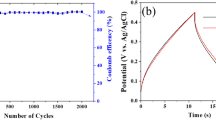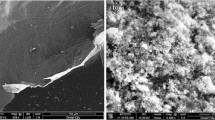Abstract
Porous cuprous oxide nanospheres were deposited on reduced graphene oxide (pCu2O NS-rGO) by a solvothermal approach that uses hexadecyltrimethylammonium bromide as the capping agent and L-glutamic acid as the reducing agent. The nanomaterial was characterized by transmission electron microscopy, Raman spectroscopy, thermogravimetry, and electrochemical methods. A glassy carbon electrode was modified with pCu2O NS-rGO, and the respective electrode displays a well expressed oxidation peak for dopamine (DA) located at 160 mV (vs. SCE). It also gives a strong peak for uric acid (UA) which is separated from the DA peak by 130 mV (vs. SCE). No signals can be detected for ascorbic acid (AA) in concentrations up to 2.0 mM. The findings are exploited in a method for simultaneous determination of UA and DA. The linear ranges are from 1.0 to 138 μM for UA, and from 0.05 to 109 μM for DA even in the presence of relatively high concentrations of AA. The detection limits are 112 nM for UA and 15 nM for DA (at an S/N ratio of 3).

Porous cuprous oxide nanospheres deposited on reduced graphene oxide was fabricated by a one-pot solvothermal method. The nanocomposites were explored to construct a sensor for simultaneous determination of uric acid and dopamine in the presence of ascorbic acid with high concentration.







Similar content being viewed by others
References
Zhang A, Neumeyer JL, Baldessarini RJ (2007) Recent progress in development of dopamine receptor subtype-selective agents: potential therapeutics for neurological and psychiatric disorders. Chem Rev 107:274
Yusoff N, Pandikumar A, Ramaraj R, Lim HN, Huang NM (2015) Gold nanoparticle based optical and electrochemical sensing of dopamine. Microchim Acta 182:2091
Wu L, Feng L, Ren J, Qu X (2012) Electrochemical detection of dopamine using porphyrin-functionalized graphene. Biosens Bioelectron 34:57
Liu A, Honma I, Zhou H (2007) Simultaneous voltammetric detection of dopamine and uric acid at their physiological level in the presence of ascorbic acid using poly(acrylic acid)-multiwalled carbon-nanotube composite-covered glassy-carbon electrode. Biosens Bioelectron 23:74
Zhang Y, Pan Y, Su S, Zhang L, Li S, Shao M (2007) A novel functionalized single-wall carbon nanotube modified electrode and its application in determination of dopamine and uric acid in the presence of high concentrations of ascorbic acid. Electroanalysis 19:1695
Zhao L, Li H, Gao S, Li M, Xu S, Li C, Guo W, Qu C, Yang B (2015) MgO nanobelt-modified graphene-tantalum wire electrode for the simultaneous determination of ascorbic acid, dopamine and uric acid. Electrochim Acta 168:191
Safavieh M, Ahmed MU, Tolba M, Zourob M (2012) Microfluidic electrochemical assay for rapid detection and quantification of escherichia coli. Biosens Bioelectron 31:523
Yang L, Liu D, Huang J, You T (2014) Simultaneous determination of dopamine, ascorbic acid and uric acid at electrochemically reduced graphene oxide modified electrode. Sens Actuators, B 193:166
Cai W, Lai T, Du H, Ye J (2014) Electrochemical determination of ascorbic acid, dopamine and uric acid based on an exfoliated graphite paper electrode: A high performance flexible sensor. Sens Actuators, B 193:492
Sanghavi BJ, Wolfbeis OS, Hirsch T, Swami NS (2014) Nanomaterial-based electrochemical sensing of neurological drugs and neurotransmitters. Microchim Acta 182:1
Zheng X, Zhou X, Ji X, Lin R, Lin W (2013) Simultaneous determination of ascorbic acid, dopamine and uric acid using poly(4-aminobutyric acid) modified glassy carbon electrode. Sens Actuators, B 178:359
Ragupathy D, Gopalan AI, Lee K-P (2010) Electrocatalytic oxidation and determination of ascorbic acid in the presence of dopamine at multiwalled carbon nanotube-silica network-gold nanoparticles based nanohybrid modified electrode. Sens Actuators, B 143:696
Zhang F, Li Y, Y-e G, Wang Z, Wang C (2011) One-pot solvothermal synthesis of a Cu2O/graphene nanocomposite and its application in an electrochemical sensor for dopamine. Microchim Acta 173:103
Reddy S, Kumara Swamy BE, Jayadevappa H (2012) CuO nanoparticle sensor for the electrochemical determination of dopamine. Electrochim Acta 61:78
Ng CHB, Fan WY (2006) Shape evolution of Cu2O nanostructures via kinetic and thermodynamic controlled growth. J Phys Chem B 110:20801
Hua Q, Cao T, Bao H, Jiang Z, Huang W (2013) Crystal-plane-controlled surface chemistry and catalytic performance of surfactant-free Cu2O nanocrystals. ChemSusChem 6:1966
Liu Y, Deng Y, Sun Z, Wei J, Zheng G, Asiri AM, Khan SB, Rahman MM, Zhao D (2013) Hierarchical Cu2S microsponges constructed from nanosheets for efficient photocatalysis. small 9:2702
Zhang H, Zhu Q, Zhang Y, Wang Y, Zhao L, Yu B (2007) One-pot synthesis and hierarchical assembly of hollow Cu2O microspheres with nanocrystals-composed porous multishell and their gas-sensing properties. Adv Funct Mater 17:2766
Anandan S, Wen X, Yang S (2005) Room temperature growth of CuO nanorod arrays on copper and their application as a cathode in dye-sensitized solar cells. Mater Chem Phys 93:35
Wang WZ, Wang G, Wang XS, Zhan Y, Liu Y, Zheng CL (2002) Synthesis and characterization of Cu2O nanowires by a novel reduction route. Adv Mater 14:67
Chang Y, Teo JJ, Zeng HC (2005) Formation of colloidal CuO nanocrystallites and their spherical aggregation and reductive transformation to hollow Cu2O nanospheres. Langmuir 21:1074
Park JC, Kim J, Kwon H, Song H (2009) Gram-scale synthesis of Cu2O nanocubes and subsequent oxidation to CuO hollow nanostructures for lithium-ion battery anode materials. Adv Mater 21:803
Zhang L, Li H, Ni Y, Li J, Liao K, Zhao G (2009) Porous cuprous oxide microcubes for non-enzymatic amperometric hydrogen peroxide and glucose sensing. Electrochem Commun 11:812
Zhang L, Ni Y, Li H (2010) Addition of porous cuprous oxide to a nafion film strongly improves the performance of a nonenzymatic glucose sensor. Microchim Acta 171:103
Wu S, He Q, Tan C, Wang Y, Zhang H (2013) Graphene-based electrochemical sensors. Small 9:1160
Tang L, Wang Y, Li Y, Feng H, Lu J, Li J (2009) Preparation, structure, and electrochemical properties of reduced graphene sheet films. Adv Funct Mater 19:2782
Xu T-Q, Zhang Q-L, Zheng J-N, Lv Z-Y, Wei J, Wang A-J, Feng J-J (2014) Simultaneous determination of dopamine and uric acid in the presence of ascorbic acid using Pt nanoparticles supported on reduced graphene oxide. Electrochim Acta 115:109
Mei L-P, Song P, Feng J-J, Shen J-H, Wang W, Wang A-J, Weng X (2015) Nonenzymatic amperometric sensing of glucose using a glassy carbon electrode modified with a nanocomposite consisting of reduced graphene oxide decorated with Cu2O nanoclusters. Microchim Acta 182:1701
Kuo CH, Chen CH, Huang MH (2007) Seed-mediated synthesis of monodispersed Cu2O nanocubes with five different size ranges from 40 to 420 nm. Adv Funct Mater 17:3773
Shang Y, Zhang D, Guo L (2012) Cucl-intermediated construction of short-range-ordered Cu2O mesoporous spheres with excellent adsorption performance. J Mater Chem 22:856
Saravanan K, Ananthanarayanan K, Balaya P (2010) Mesoporous TiO2 with high packing density for Superior lithium storage. Energy Environ Sci 3:939
Pham VH, Pham HD, Dang TT, Hur SH, Kim EJ, Kong BS, Kim S, Chung JS (2012) Chemical reduction of an aqueous suspension of graphene oxide by nascent hydrogen. J Mater Chem 22:10530
Chen J, Sheng K, Luo P, Li C, Shi G (2012) Graphene hydrogels deposited in nickel foams for high-rate electrochemical capacitors. Adv Mater 24:4569
Song P, Feng J-J, Zhong S-X, Huang S-S, Chen J-R, Wang A-J (2015) Facile preparation of reduced graphene oxide supported PtNi alloyed nanosnowflakes with high catalytic activity. RSC Adv 5:35551
Vilar-Vidal N, Rivas J, López-Quintela MA (2012) Size dependent catalytic activity of reusable subnanometer copper(0) clusters. ACS Catal 2:1693
Goswami N, Giri A, Bootharaju MS, Xavier PL, Pradeep T, Pal SK (2011) Copper quantum clusters in protein matrix: potential sensor of Pb2+ ion. Anal Chem 83:9676
Madasamy T, Pandiaraj M, Balamurugan M, Bhargava K, Sethy NK, Karunakaran C (2014) Copper, zinc superoxide dismutase and nitrate reductase coimmobilized bienzymatic biosensor for the simultaneous determination of nitrite and nitrate. Biosens Bioelectron 52:209
Ensafi AA, Taei M, Khayamian T, Arabzadeh A (2010) Highly selective determination of ascorbic acid, dopamine, and uric acid by differential pulse voltammetry using poly(sulfonazo III) modified glassy carbon electrode. Sensors Actuators B Chem 147:213
Zhao D, Fan D, Wang J, Xu C (2015) Hierarchical nanoporous platinum-copper alloy for simultaneous electrochemical determination of ascorbic acid, dopamine, and uric acid. Microchim Acta 182:1345
Xing L, Ma Z (2015) A glassy carbon electrode modified with a nanocomposite consisting of MoS2 and reduced graphene oxide for electrochemical simultaneous determination of ascorbic acid, dopamine, and uric acid. Microchim Acta 183:257
Tsierkezos NG, Ritter U, Thaha YN, Downing C, Szroeder P, Scharff P (2015) Multi-walled carbon nanotubes doped with boron as an electrode material for electrochemical studies on dopamine, uric acid, and ascorbic acid. Microchim Acta 183:35
Acknowledgment
This work was financially supported by National Natural Science Foundation of China (Nos. 21475118, 21275130, 21275131, 21505121 and 21506195).
Author information
Authors and Affiliations
Corresponding authors
Ethics declarations
The authors declare that they have no competing interests.
Electronic supplementary material
ESM 1
(DOC 619 kb)
Rights and permissions
About this article
Cite this article
Mei, LP., Feng, JJ., Wu, L. et al. A glassy carbon electrode modified with porous Cu2O nanospheres on reduced graphene oxide support for simultaneous sensing of uric acid and dopamine with high selectivity over ascorbic acid. Microchim Acta 183, 2039–2046 (2016). https://doi.org/10.1007/s00604-016-1845-0
Received:
Accepted:
Published:
Issue Date:
DOI: https://doi.org/10.1007/s00604-016-1845-0




